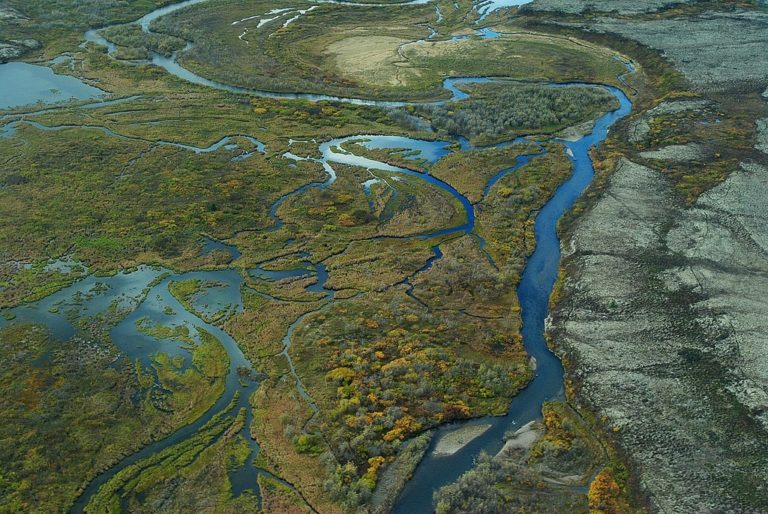
By Peter D. Kalicki. Peter received his B.A. from Columbia University and plans to focus on environmental law during law school. He currently serves as an advocacy intern at Waterkeeper Alliance. Photo by the U.S. Environmental Protection Agency.
Once again, a massive open-pit copper and gold mine proposal is threatening one of the world’s last great salmon fisheries. For years, the Pebble Mine project has faced fierce opposition from local communities, including from Alaskan Native and commercial fishing groups, in part due to its proximity to famed Bristol Bay. If built, Pebble would be one of the largest mines in the world, threatening nearby waterways with heavy metals and other toxic pollutants.
Bristol Bay is home to the world’s largest salmon fishery, supporting all five species of Pacific salmon and producing about 46 percent of the world’s sockeye salmon harvest. It also provides habitat for 29 fish species, over 190 bird species, and over 40 terrestrial animals. Bald eagles, moose, brown bears, freshwater seals, beluga whales, and many other species rely on Bristol Bay’s well-being for their survival.
Cook Inletkeeper Bob Shavelson, noted the serious threat that this project poses: “Clearly, our system to protect wild salmon habitat is broken. If it weren’t, our agencies and decision makers would be listening to the millions of people who support healthy wild salmon fisheries in Bristol Bay. They would listen to the science that clearly shows the impacts are too great, and the risks are too high, for a project like Pebble at the headwaters of Bristol Bay.”
By destroying the part of the watershed and threatening Bristol Bay with toxic pollutants, the Pebble Mine not only imperils animals and the ecosystems they inhabit but also endangers the livelihood of thousands of people who live and work in Alaska. The Bristol Bay watershed supports a $1.5 billion commercial and sport fishery and generates nearly 20,000 jobs throughout the United States. The Pebble Mine project threatens, even by conservative estimates by the U.S. Environmental Protection Agency (EPA), to destroy 94 miles of salmon stream and over 5,000 acres of wetlands, lakes, and ponds, causing permanent harm to Bristol Bay and the people who depend on it for a living.
And Bristol Bay is not the only ecosystem threatened by Pebble Mine. Gas pipelines to power the mine would harm salmon and marine mammals in Cook Inlet and other lakes and waterways as well. With a profound understanding of the cultural and economic importance of these water bodies, over 80 percent of Alaskan Natives oppose the project.
Recognizing these dangers, a series of investors have withdrawn their support for the project, and in 2014, EPA moved to impose restrictions on the construction of the Pebble Mine. But following a meeting between Pebble executives and EPA Administrator Scott Pruitt in May 2017, Trump’s EPA announced plans to abandon these vital restrictions and allow the Pebble project to move forward. As part of the resurrection, the company behind Pebble changed the location of the proposed export terminal to a location where it would truck, barge, and then ship ore across treacherous sea conditions. Cook Inletkeeper Bob Shavelson recently traveled to the proposed Pebble mine export terminal site. His blog about the investigative trip concludes, among other things, that “any company that invests in Pebble has to have its head examined because Pebble doesn’t have a serious mine plan.”
Pebble Limited Partnership has applied for a permit from the U.S. Army Corps of Engineers to begin this project, and the Army Corps is currently holding a public comment period. The agency is asking for information from the public about what they should include in their analysis of the project.
We need you to speak up for Alaskan salmon and everyone who depends upon them for food and income. Submit your comment to the Army Corps by June 29th. You can use this template to get you started. Please personalize the template below to include the impacts you are most worried about. You can read some more tips on commenting here.
Template:
Thank you for this opportunity to provide input on the impacts of the Pebble Mine. I am writing because I believe that the environmental impacts of this project far outweigh any benefits. Specifically, I urge the U.S. Army Corps to consider the following:
- The Pebble Partnership must provide current and complete information in its permit application. The baseline data included in Pebble’s application is over 10 years old and thus obsolete. Pebble should also conduct an independent economic feasibility analysis and include it in its application.
- The Army Corps should compare Pebble’s plans to the Environmental Protection Agency’s (EPA) previous analysis. EPA found that even a smaller mine would result in a “complete loss of fish habitat” in Bristol Bay; Pebble’s current plans are even more harmful and will destroy 4,000 acres of wetlands and over 5 miles of anadromous streams. The Army Corps should also examine alternative locations to mine copper and gold other than Pebble’s proposed site in Bristol Bay’s headwaters.
- The Army Corps should examine the full extent of Pebble’s planned operations and the resulting impacts. Pebble has unreasonably asked the Army Corps to limit its review to a small 20-year mine, even though it plans to operate its mine for up to 200 years, extracting up to 11 billion tons of ore.
Please reject Pebble’s current permit application as outdated, incomplete, and unrealistic.